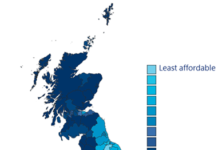- Wales has highest house price growth at 9.4%
- In England, North and South regional price change has “flipped”
- London growth rate now 7.1%
- Yorkshire and Humber at 1.9%

Richard Sexton, director at e.surv, comments:
“Wales has continued to outperform other regions and continues to occupy first place in the annual price growth league for the sixth month in succession, with an annual rate of 9.4%. The race for space during the pandemic has supported the demand for property in Wales. The growth of the second homes market in Wales has caught the attention of many commentators and policy makers.
“However, this strong continued performance in Wales has not been repeated across the country where regional fortunes have been turned on their head. There has been a significant change in the fortunes of areas such as the North West which has slipped from second place in June to eighth. This is in contrast with the south eastern parts of England. To understand why this has happened we need to appreciate the impact of the withdrawal of the Stamp Duty Land Tax in September.
“Our index over the past 12 months has already shown how the SDLT has impacted the UK house market over that period as a national incentive to stimulate activity. But now the index is reflecting the impact of the way it was ultimately withdrawn.
“The staggered reduction of the SDLT tax holiday proportionately helped those buying at the lower end of the price scale, when the savings to buyers were not insignificant if they were buying a property valued at £250,000 (the average price in the East Midlands is currently £251,604). But this saving is of lesser significance in the South East, where average prices amount to £443,778. The end of the SDLT holiday has effectively meant that the wealthier regions are now more prominent in the reporting.”

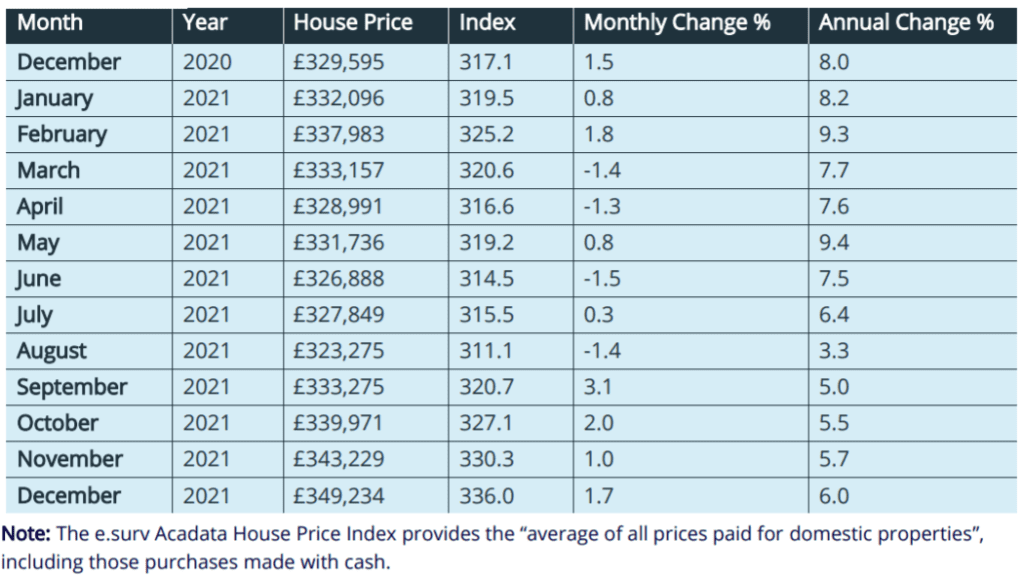
Commentary: John Tindale and Peter Williams, Acadata Senior Analysts
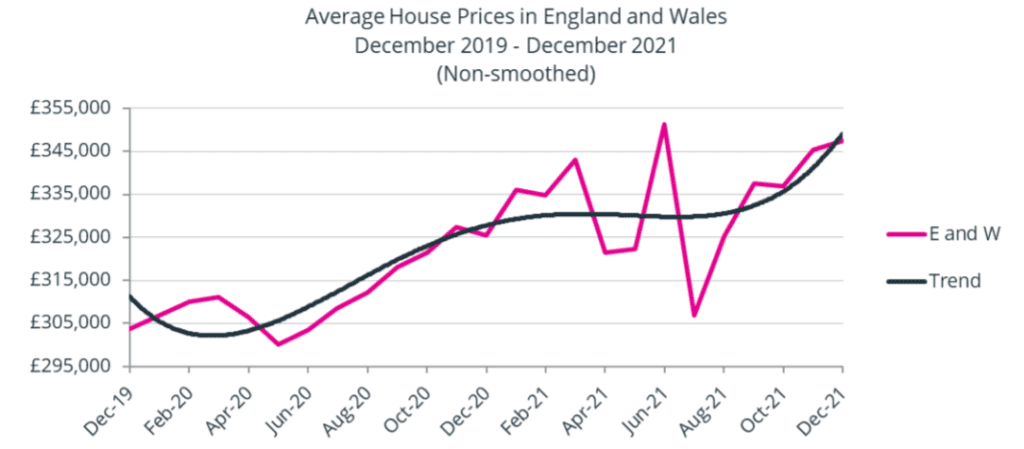
The main drivers in the housing market over the last two years have been the underlying increase in demand, associated with the “race for space”, along with the onset of working from home and a reassessment of lifestyles. These factors – combined with the stamp duty holidays, which stimulated three peaks in the market in terms of both prices and transactions – are all in turn underpinned by the record low levels of interest rates and increased savings, hence making housing more affordable over the last two years.
Figure 1 shows that house prices have continued to climb in Q4 2021, albeit at a slowing rate, despite the various stamp duty holidays coming to an end. However, although the direction of travel is the same across both countries, it is evident that at a regional level each area has varying metrics which cause differing outcomes at the more local level. This is our focus in the next section.
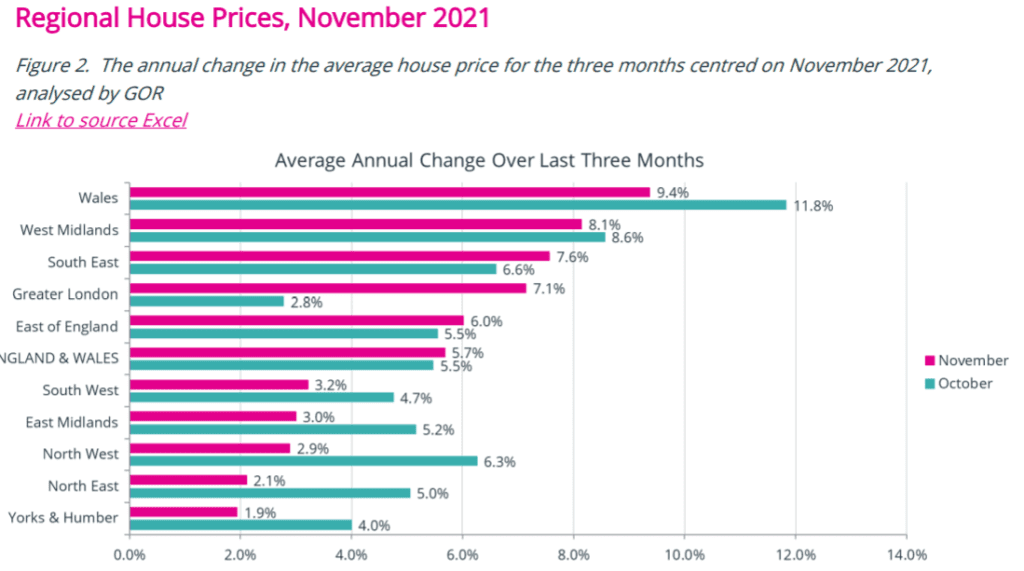
Regional reporting stands at the heart of the Acadata release, reflecting the great diversity of market performance across England and Wales. Figure 2 shows the percentage change in annual house prices on a regional basis in England and Wales for November, averaged over the three-month period of October, November and December 2021, compared to the same three months in 2020. It also shows the similarly averaged figures from October 2021.
In general terms, we can note that all areas – except for the south eastern part of England, made up by Greater London, the East of England and the South East – have seen their annual rates of growth continue to fall from the minor peak in prices which was recorded In September, the last month in which the SDLT tax holiday in England was operational.
Wales continues in top place in the annual price growth league for the sixth month in succession, with an annual rate of 9.4%, although this was down by 2.4% from the previous month’s rate of 11.8%. Many commentators, including Wales’ First Minister, Mark Drakeford, are of the view that this high rate of price inflation has been exacerbated by second homes purchases in some parts of Wales.
But aside from Wales, which has resolutely had the highest house price growth in England and Wales over the last six months, we have seen a number of changes in the GOR area rates since June 2021 – which month depicts the height of the change in house prices during the pandemic – and in England was also the last month of the full £15,000 savings that were available from the SDLT tax holiday on properties costing £500,000, or higher.
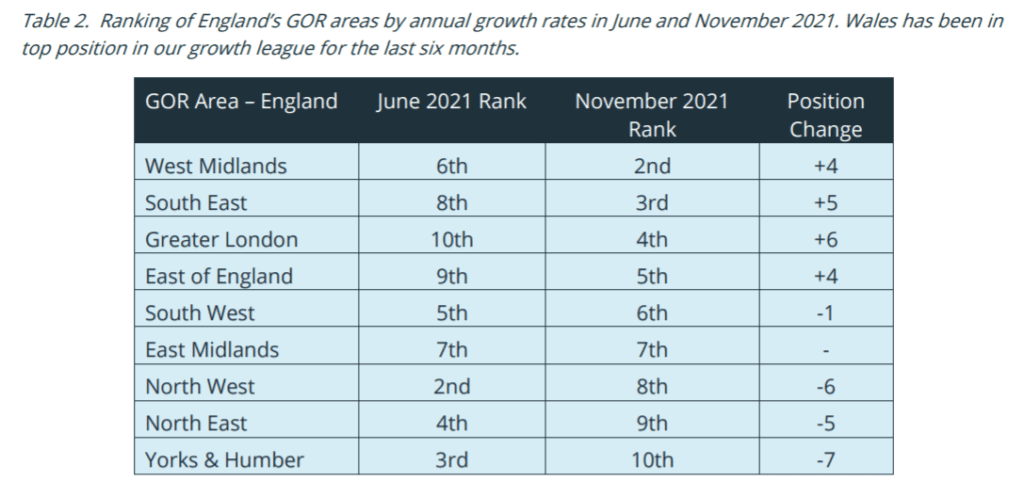
Table 2 above shows the ranking of the nine GOR areas in England for June and November 2021 in terms of annual house price growth. Aside from the West Midlands, we can see that the Northern regions have flipped their respective positions with the regions of the South East of England over the last few months. For example, the North West, which in June was in second place in terms of annual house price growth, is now ranked eighth, with Yorkshire and the Humber similarly falling from third place into tenth position and the North East from fourth place into the number nine spot.
Meanwhile, the three regions in the south east of England have all climbed up the table. The South East is now in third place, from eighth, the East of England is up four places from ninth to fifth, while Greater London is up from tenth to fourth place.
So why has this ‘flip’ taken place? In part it is due to the disappearance of the SDLT tax holiday in September – which, at its reduced rate, proportionately helped those buying properties at the lower end of the price scale, when the tax savings amounted to a maximum of £2,500. This saving was not an insignificant sum to those buying a property valued at £250,000 (for example the average price in the East Midlands is currently £251,604), but is of lesser significance in the South East, where average prices amount to £443,778. With the SDLT holiday over, the wealthier regions are now more evident.
England and Wales Regional Heat Map for November 2021
All of these different trends are then highlighted in the Regional Heat Map for November. The Map is looking remarkably different from that published last month. This month we can see a swathe of red/pink crossing the country on an east/west axis, being led by Wales at 9.4%, followed by the neighbouring West Midlands at 8.1% and the South East at 7.6%, with Greater London at 7.1%. To the south of this line we have the South West at 3.2%, with to the north the East Midlands and the North West at 3.0% and 2.9% respectively. Finally, we have the two areas which are shaded blue, being the North East, at 2.1% and Yorkshire and the Humber at 1.9%. As stated above, back in June these two areas held fourth and third positions respectively.
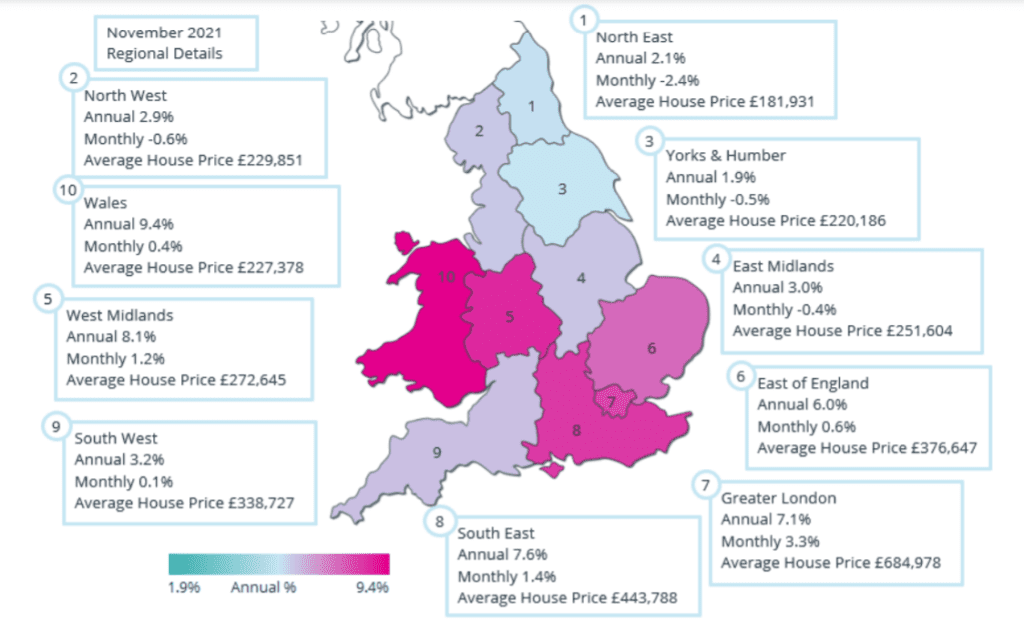
December – Annual Price Trends
Another way of viewing the recent ascendancy of the South East and Greater London is shown in Figure 3 below.
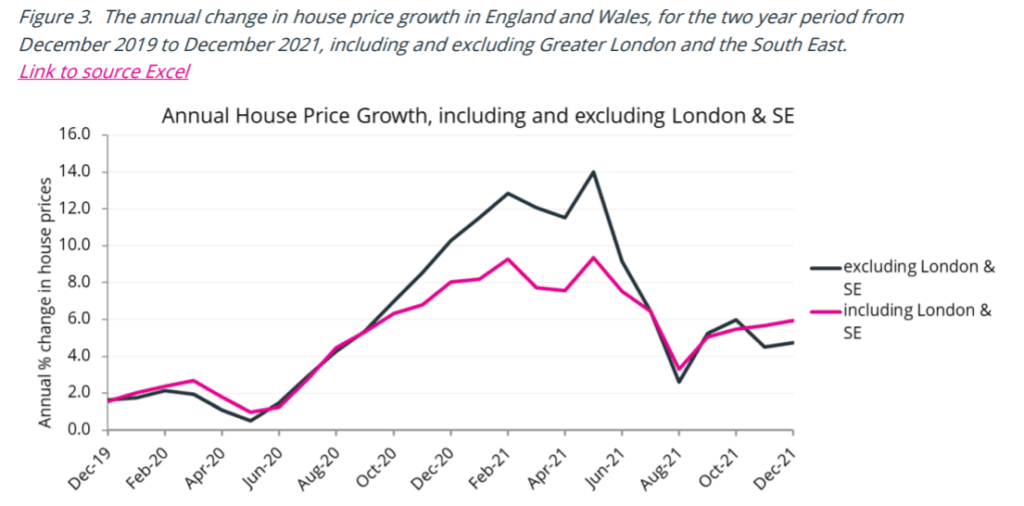
The above Chart shows the annual growth rate over the last two years for England and Wales, including and excluding Greater London and the South East. As can be seen, the annual rates of house price growth between these two groupings were similar up to September 2020, but then started to diverge, with London and the South East holding back the national rates from September 2020 to July 2021. These dates roughly align with the period when the SDLT tax holiday was at its maximum in England, and the equivalent LTT holiday was also operational in Wales.
For the period from July 2021 to September 2021, the LTT tax holiday in Wales had ceased and the SDLT holiday in England was operating at a much-reduced rate. During this period, the annual rates in England and Wales were again broadly similar whether including or excluding Greater London and the South East. However, from October 2021 we can see that the two groupings have again diverged, with Greater London and the South East witnessing higher growth rates.
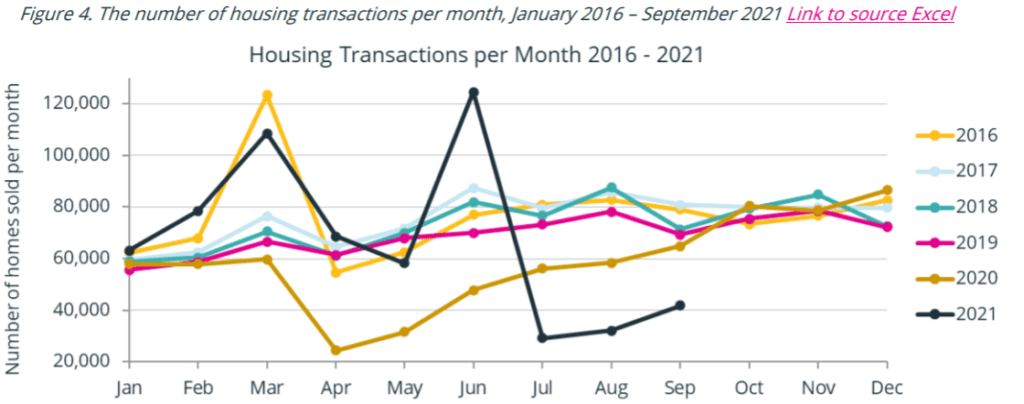
Figure 4 shows the number of domestic housing transactions recorded in England and Wales at the Land Registry per month for the period from January 2016 to September 2021. The month designated is that of contract completion, i.e. the date when a property legally changes hands.
There are three conspicuous peaks on the graph and three associated troughs. They are all stamp duty related events. Looking at the peaks, these took place in March 2021, June 2021 and March 2016. The March 2021 event was one month prior to the original date for Chancellor Sunak’s SDLT tax holiday to end – this termination date was in fact extended to 30 June 2021 at its full rate, and to 30 September 2021 at its reduced rate – but the announcement of its extension wasn’t made until 3 March 2021, and many purchasers had already made plans to buy a property within the original timescale – hence the March 2021 spike. The second peak took place in June 2021 and was the final date within which the full SDLT tax holiday was available, under Sunak’s revised plans.
HMRC has published its estimates for domestic property sales in England and Wales for September 2021, suggesting that a further spike of 150,000 transactions took place in that month – but the Land Registry has to date only recorded 42,000 purchases for the month – watch this space!
The other peak on the chart shows the 123,500 transactions that took place in March 2016 in England and Wales. This occurred one month ahead of the introduction of the 3% additional SDLT surcharge on second homes and buy-to-let properties, which caused a flurry of purchases in the month to forestall the payment of the additional tax in April of that year.
Each spike in transactions tends to be followed by a trough in sales, reflecting the ability of buyers to bring forward their purchase into an earlier month.
Taking stock on 2021 and 2022
In 2021, the housing markets of England and Wales have exceeded expectations when looked at in terms of prices and transactions, driven forward not least by factors that are unlikely to be repeated in 2022, e.g., the tax holidays. But strong demand remains, buoyed not least by savings, with also still a shortage of stock on the market, as RICS housing market surveys continue to show. There has thus been strong competition for limited stock and there is little to suggest that this is about to change quickly. For some, moves are entirely discretionary and the pandemic has inevitably induced a new level of caution in terms of making such adjustments.
Looking ahead, published forecasts suggest that the market is likely to be slower than in 2021, and commentary has focussed on a return to what are seen as more normal conditions. The recent summary of independent forecasts published by HM Treasury gives a real sense of the divergence of opinion with the 12 organisations reporting price expectations for Q4 2021 to Q4 2022 ranging from -0.6% to + 5.6% with a median of + 2.0%, although we have yet to see what the future holds.

| [donate]
| Help keep news FREE for our readersSupporting your local community newspaper/online news outlet is crucial now more than ever. If you believe in independent journalism,then consider making a valuable contribution by making a one-time or monthly donation. We operate in rural areas where providing unbiased news can be challenging. |


















